
Video content captures attention in a way that text or images alone cannot. Potential customers often prefer watching a short product video to quickly understand the features, benefits, and how the product fits into their lives.
Platforms like social media, YouTube, and various streaming services have significantly increased the reach and sharing potential of product videos. A well-crafted and engaging video can go viral, exponentially expanding brand visibility.
This article will teach you how to create videos that bring products to life and connect with your audience on a personal level. The instructions are based on the methodology we employed to create our first product video for Touchpoint.
What is a product video?
A product video is a short audiovisual clip created to showcase and promote a product, its features, benefits, and uses. It highlights what makes the product special and why people should consider buying it. These videos are crafted to be engaging, informative, and visually appealing, aiming to grab the viewer’s attention and create interest in the product.
The following are some common types of product videos often utilized by companies to showcase their offerings.
Teaser/Promo
Teaser or promotional videos offer a sneak peek or a glimpse of the product, often generating excitement and curiosity.
👍 Best time to use: Use teasers to create anticipation before the product launch. They’re also great for social media or email marketing campaigns to pique interest.
Explainer
Explainer videos provide a clear and concise explanation of what the product does, its key features, and how it can solve a problem or fulfill a need.
Demo
Demo (demonstration) videos show the product in action, illustrating its usage, benefits, and real-life applications.
Why should you create a product video?
Here are the key benefits that product videos can bring to a business.
- Increased engagement: Product videos seize and hold the attention of viewers more effectively than solely text or images. They are visually appealing and can quickly convey information, keeping viewers interested.
- Enhanced understanding: Videos provide a clear and visual demonstration of the product. This improves comprehension and influences purchasing decisions.
- Improved conversion rates: When viewers see a product in action and understand its value, they are more likely to purchase it.
- Better SEO and visibility: Videos can improve a website’s search engine ranking, increasing visibility. Search engines like Google often prioritize video content.
- Storytelling and branding: Product videos offer a creative medium to tell your brand story. You can connect emotionally with your audience, which creates a stronger brand identity.
How to make a product video compelling?
Creating a compelling product video is like telling a captivating story – it needs to grab attention, keep the audience engaged, and leave a lasting impression. These are the key elements that help you get there:
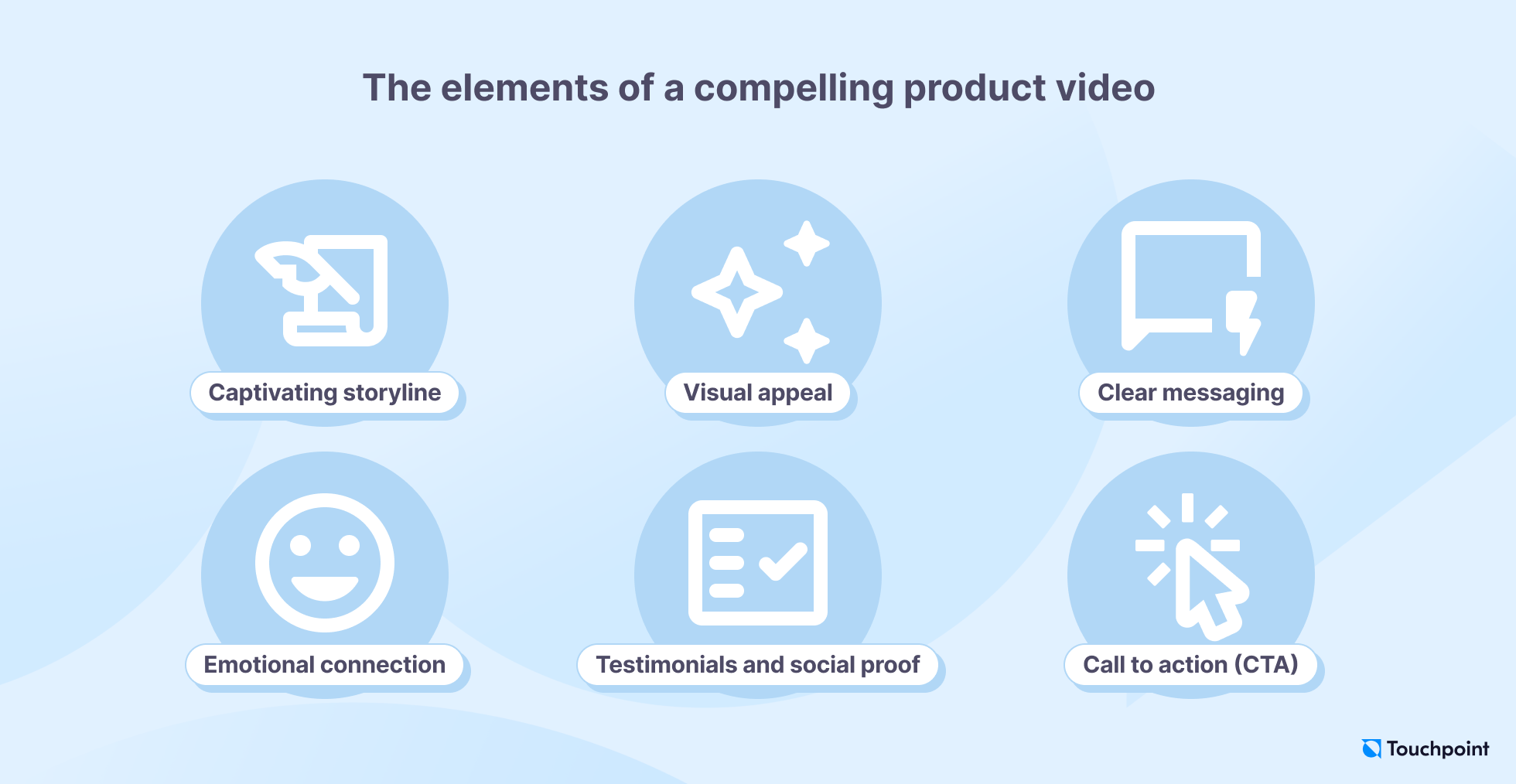
- Captivating storyline: Every good video has a story. In the case of a product video, the story revolves around the problem the product solves, how it solves it, and the positive change it brings to the customer’s life.
- Visual appeal: High-quality visuals, appealing colors, and engaging graphics can grab attention and keep viewers hooked.
- Clear messaging: The message should be clear and concise. Explain what the product is, what it does, and why it’s valuable. Avoid jargon and complicated language.
- Emotional connection: A compelling video triggers emotions. It could be excitement, happiness, or even humor. Viewers are more likely to remember and share the video when they feel connected.
- Testimonials and social proof: Including testimonials from satisfied customers or influencers builds trust. People trust recommendations from others.
- Call to action (CTA): A compelling video should guide viewers on what to do next – visit a website, purchase, or sign up for a newsletter. A strong CTA encourages action.
How we created our first product video
Now that we have the basics covered, let’s talk about the steps we took to go from concept to realization with our first SaaS product video – an explainer for our soon-to-be-launched customer service platform Touchpoint.
1. Defining our audience and purpose
Our first step was to align the product and marketing team around the purpose of the video. This made it easier to put together a project brief for our video partners in the later stages. Here are the things that we covered.
- Brand: Our vision, mission, and goal as a brand.
- Positioning: The vertical that we want to disrupt and the pain points we are trying to solve.
- Ideal customer profile: We created ICPs with the following information – demographics, roles, interests, pain points, motivators, sources of info, etc.
- Messaging: We created a two-sentence description of our product and highlighted the key benefits and advantages that are relevant to our ICPs.
- Video length and format: We agreed on the duration of the video (60, 30, and 15 seconds) and the formats needed (landscape, reel, etc.).
- Video distribution: We chose the platforms where our video would be distributed (YouTube, Vimeo, Facebook, Instagram, etc.).
- Video examples and creative approaches mood board: Our team collected several product videos that aligned with our vision.
- Budget: How much we were willing to spend on the making of the video.
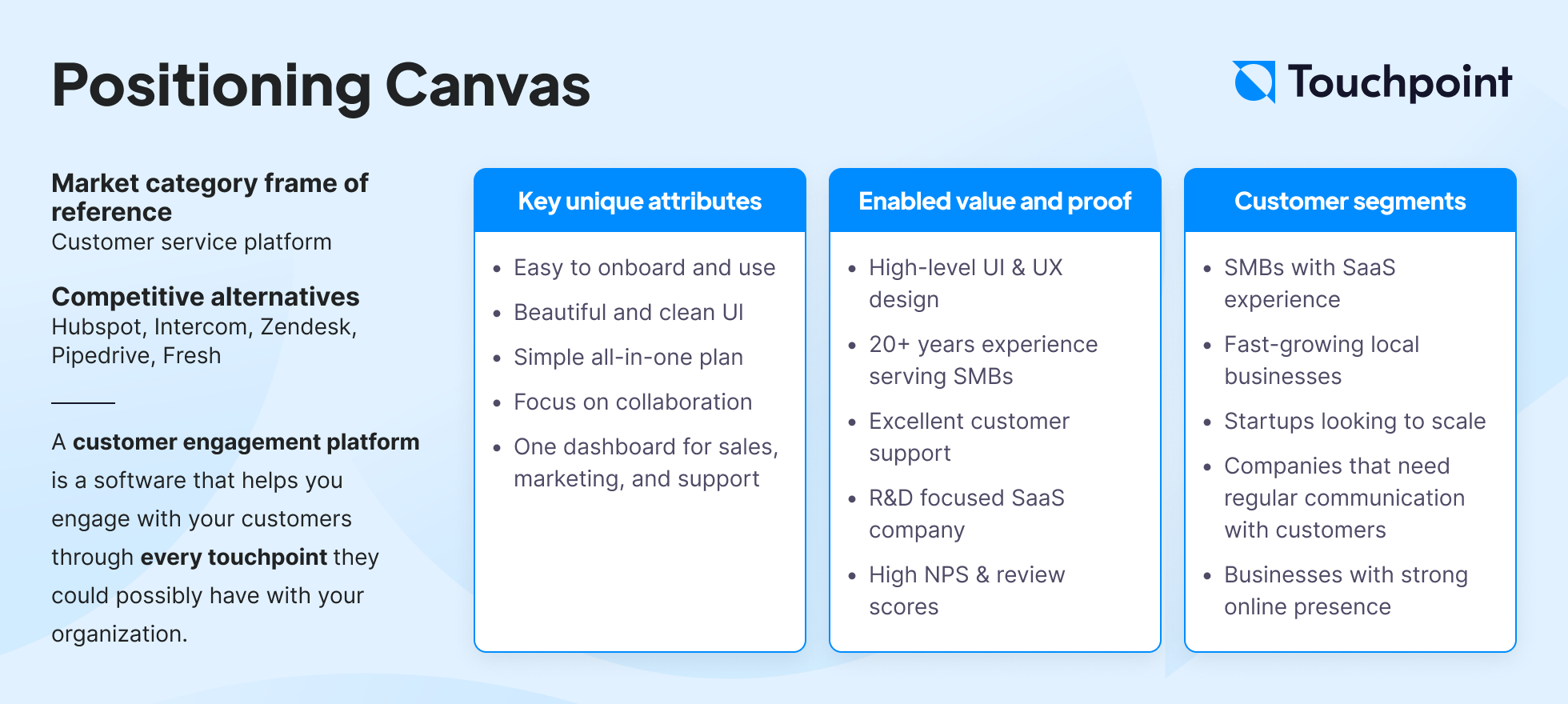
2. Selecting our video production partner
The next step was to identify the best video partner. While product videos can also be created in-house, which is what we are doing for our new TextMagic demo, a partner comes with more experience in formats or approaches that work best.
Here are the steps that we took in choosing the partner.
- We researched videos and identified the agencies that created them. One of our favorites was the Toggl video. We contacted their team and found out that the video was produced by Vidico.
- We checked the partner’s website portfolio and some case studies to see if they have experience creating videos in the style that we wanted. We found many relevant videos in Vidico’s portfolio.
- We checked the reviews and feedback from other customers.
- We researched pricing information to ensure the partner was within our budget range.
3. Team and project onboarding
Once we decided on our partner, we reached out and consulted them on cooperation possibilities and the production process.
3.1. Legal agreements
Working with an external partner requires careful planning. You should ensure that the legal agreement sets clear expectations of deliverables on both sides. Below are some of the main aspects we considered when drafting the contract:
- Project scope and objective (description, length, style, and tone)
- Stages of the project and timelines (pre-production, production, post-production)
- Deliverables (final video, additional assets, and their formats)
- Number and scope of revisions
- Costs and payment
- Intellectual property rights
3.2. Team onboarding
Now that we have the admin side covered, let’s move on to team onboarding. Since we were already internally aligned on what we wanted (see step 1), the onboarding process went smoothly.
Here are the main things that you should provide to your video partner for better collaboration:
- Briefing about the audience and purpose of the video
- Your brandbook and product visuals
- A general moodboard
- Design constraints and considerations
During this stage, it’s also essential to establish your cooperation flow:
- Introduce the team members on both sides
- Decide on the key stakeholders of the project
- Agree on production stages and acceptance procedures
- Break down the project timeline
- Agree on the tools that will be used
4. Pre-production: Creating the video script
Depending on your preference, the video script can be created internally or by the partner. For us, it was a joint effort. This worked very well because our partner had an outside perspective and could identify immediately obvious product differentiators.
We used Notion to iterate on the script and implemented a few strategies to validate it:
- Tested the video script with text-to-speech tools and AI voice-over tools to understand how it sounds and fits into our timeframe
- Generated word clouds from the video script to identify main themes and keywords
- Went through two rounds of reviews and improvements
5. Pre-production: Video storyboarding
We cannot stress the value of storyboarding enough. Creating a visual sequence for your video before the production phase ensures that all elements of the video (visuals, audio, etc.) come together in a straightforward way and that the product is presented correctly.
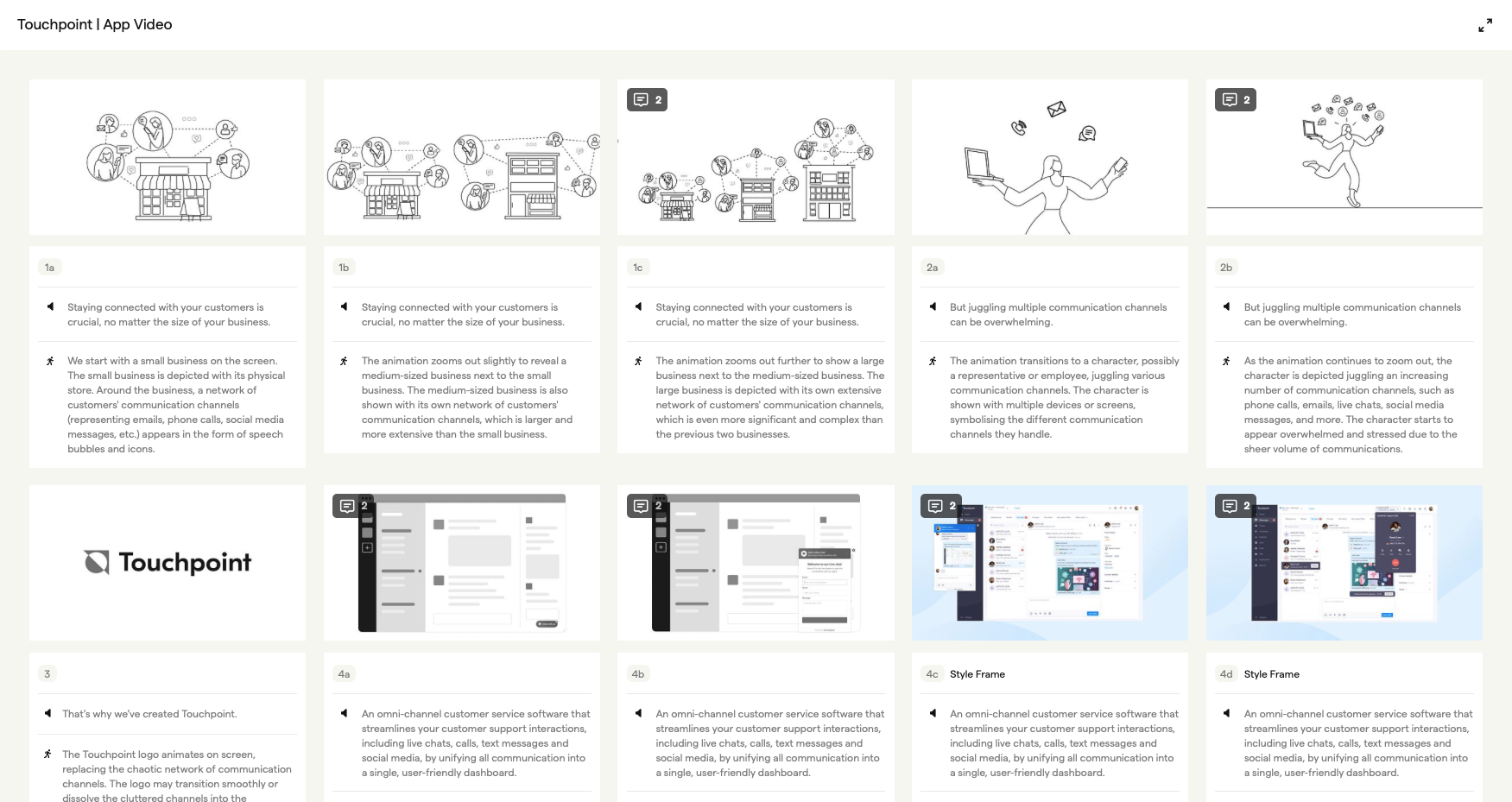
It is also a great way to optimize time and costs before you go to the production phase. The storyboarding stage was also the most difficult part of the process for us because we wanted to ensure that the Touchpoint product value was correctly conveyed.
In total, we had three review rounds. For each of them, we had internal meetings with our product, design, and marketing teams. We went through every little detail of the script, audio, and visuals, which were neatly organized in the Boords tool.
🎞️ The storyboard format made it easy to add relevant comments for every second of the video and process it quickly with our partner.
6. Production: Illustration, design style, and voice-over
Once we were happy with the wireframe storyboard, we moved on to the illustration and design phase. During this stage, our team encountered various challenges when integrating the UI into a video format.
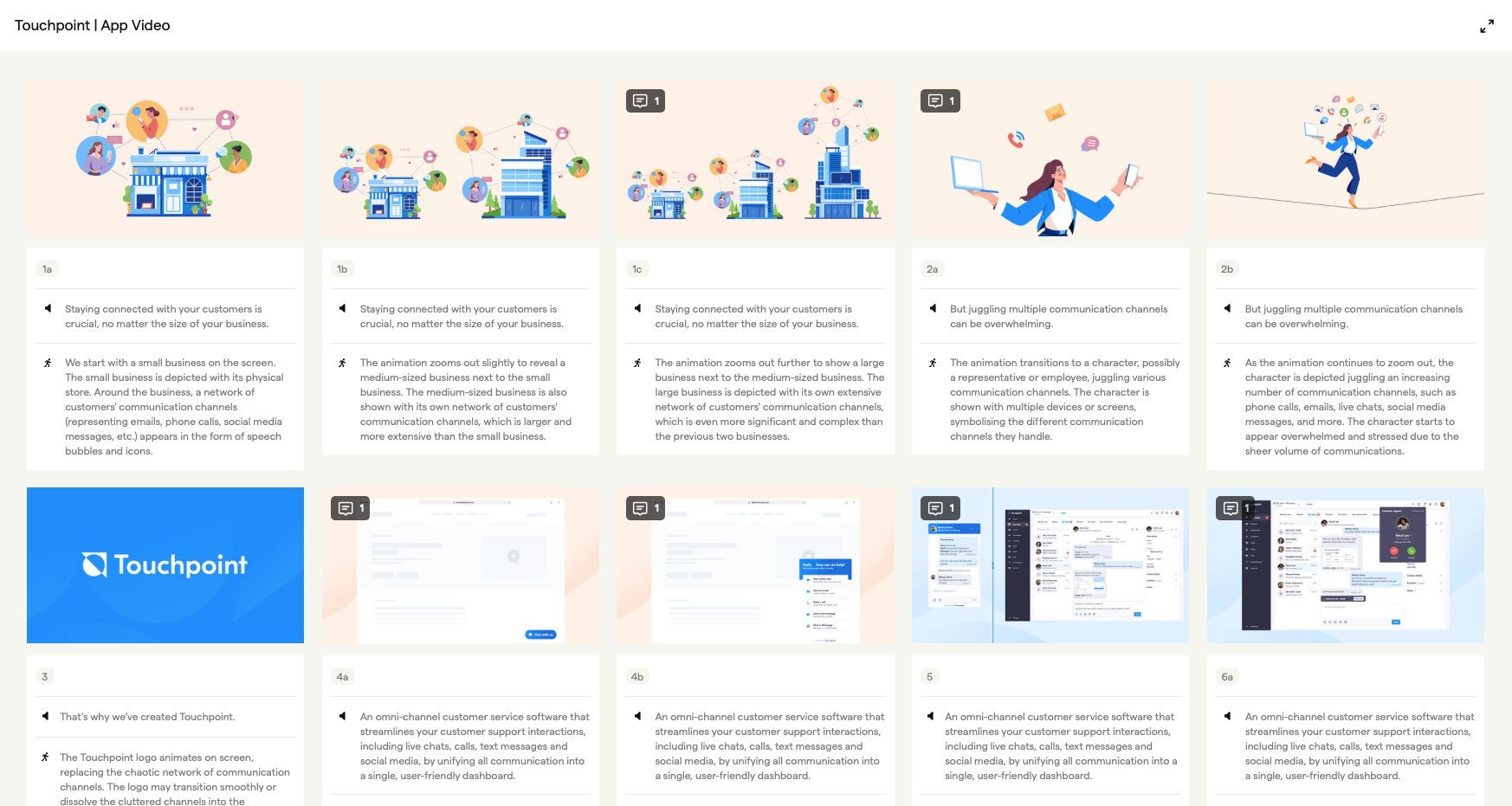
We had to carefully consider the intensity of colors used, the level of detail displayed in the app, and the precise wording of microcopy on UI elements. For instance, our customer profile page, which was intricately designed, appeared overwhelming when incorporated into the video.
Our product management and internal product designers provided valuable input during this phase, offering suggestions on UI elements to be included in the video and providing examples of other visual elements. We also made slight alterations to the script to better align with the screens being displayed.
In parallel, we made a selection of the voiceover audio. Vidico had a very good library of different voices. We asked them to make a recommendation about the audio and made a selection based on that. A similar approach was taken when selecting the background music.
7. Production: Animation phase
After several rounds of review, we closed the design phase and moved to animation. This approach ensured that we never had to reiterate the phases that were already approved. We had a total of 2 review rounds during this phase and used Frame.io for collaboration and feedback.
This stage was pivotal in the completion of our product video, where the integration of audio effects, text, and visuals provided a comprehensive representation. We made some refinements to emphasize our message, resulting in a video duration increase from 60 to 67 seconds.
🎥 Have confidence in your video partner’s expertise in crafting appropriate animations and audio effects. While minor adjustments may be necessary from your end to ensure timings are consistent and aligned with brand guidelines, trusting their experience is key.
8. Post-production: Creating cutoffs
As stated in the initial stages, our objective included crafting shorter videos for our social media platforms. To achieve this, we needed to modify and reformat the main video to meet the specific size and duration requirements for various platforms. We opted for video cutoffs of 30 seconds, 15 seconds, and 6 seconds.
Collaborating closely with our partner, we pinpointed the critical elements of the main video and effectively condensed them into the shorter videos. Each shorter video was tailored to convey a clear and distinct message.
9. Project sign-off
Prior to finalizing the project, we extended the opportunity for our extended team to review the work, and the response was overwhelmingly positive! 🎉
As a best practice before officially concluding any project, we suggest revisiting the contract to confirm receipt of all production materials and deliverables, as well as ensuring financial matters are appropriately settled on both ends.
🤝 Maintain an open line of communication for potential future collaborations, now that you have a partner well-versed in understanding your brand.
10. Video distribution
No one knows about the video until you have distributed it. Although we have published the video on our main website and YouTube channel, this step is still a work in progress for us, since Touchpoint is launching in open beta at the end of October.
Once we’ve officially launched Touchpoint, we will also distribute the video cut-offs on social media. We will be promoting the main video on product review sites and on partner websites.
Our tips for crafting the best product video
Implementing the following tested practices will help ensure a smooth collaboration with your production partner and an exceptional product video outcome that resonates with your target audience.
Establish effective communication channels
- Schedule regular meetings with the production team to discuss progress, challenges, and next steps. Use video conferencing or collaboration tools to facilitate these discussions.
- Utilize project management platforms like Asana, Trello, or Monday.com to track progress, assign tasks, and communicate project updates centrally.
- Establish guidelines for communication, including preferred channels (email, messaging apps, calls) and response times, to maintain smooth and timely information exchanges.
Define roles and responsibilities
- Develop a clear responsibility matrix outlining who is responsible for what tasks and decisions at each stage of the video production process.
- Appoint a project coordinator from your team to liaise with the production partner and ensure that tasks are completed according to schedule and quality standards.
- Conduct joint meetings between your team and the production partner’s team to align on roles, expectations, and coordination mechanisms.
Involve all relevant stakeholders for feedback
- Engage stakeholders from the onset to understand their vision and expectations for the product video. This sets the right direction for the production process.
- Organize structured feedback sessions at significant milestones, such as script development, storyboard approval, and rough cuts. Collect input and suggestions from stakeholders to refine the video progressively.
- Leverage online collaboration tools that allow stakeholders to provide timestamped feedback directly on the video, streamlining the feedback collection process.
Four product video mistakes to avoid
Here are the common pitfalls that can undermine your video production efforts if left unchecked.
1. Not having a clear message or objective
This often results in a confusing or directionless video that fails to resonate with the audience.
Solutions:
- Clearly define the purpose of the video.
- Identify what message you want to convey and the action you want viewers to take after watching it.
2. Overloading the video with information
Including too much information in a product video can overwhelm viewers, making it difficult for them to grasp the key features and benefits of the product.
Solutions:
- Prioritize the most crucial information and present it in a structured, easy-to-digest manner.
- Stick to the essential features and benefits directly addressing the target audience’s needs or pain points.
3. Neglecting the importance of audio quality
Poor audio quality can detract from the overall video experience, making it difficult for viewers to follow the content or understand the message clearly.
Solutions:
- Invest in a good quality microphone and ensure a quiet recording environment.
- Pay attention to clear and crisp audio that complements the visuals.
4. Forgetting to optimize for mobile viewers
Creating a product video that doesn’t display well on mobile devices can result in a poor viewing experience as more people access content via smartphones.
Solutions:
- Optimize the video for mobile viewing by ensuring it’s formatted to fit mobile screens, loads quickly, and has clear visuals even on smaller screens.
- Test the video across various devices to guarantee a seamless viewing experience.
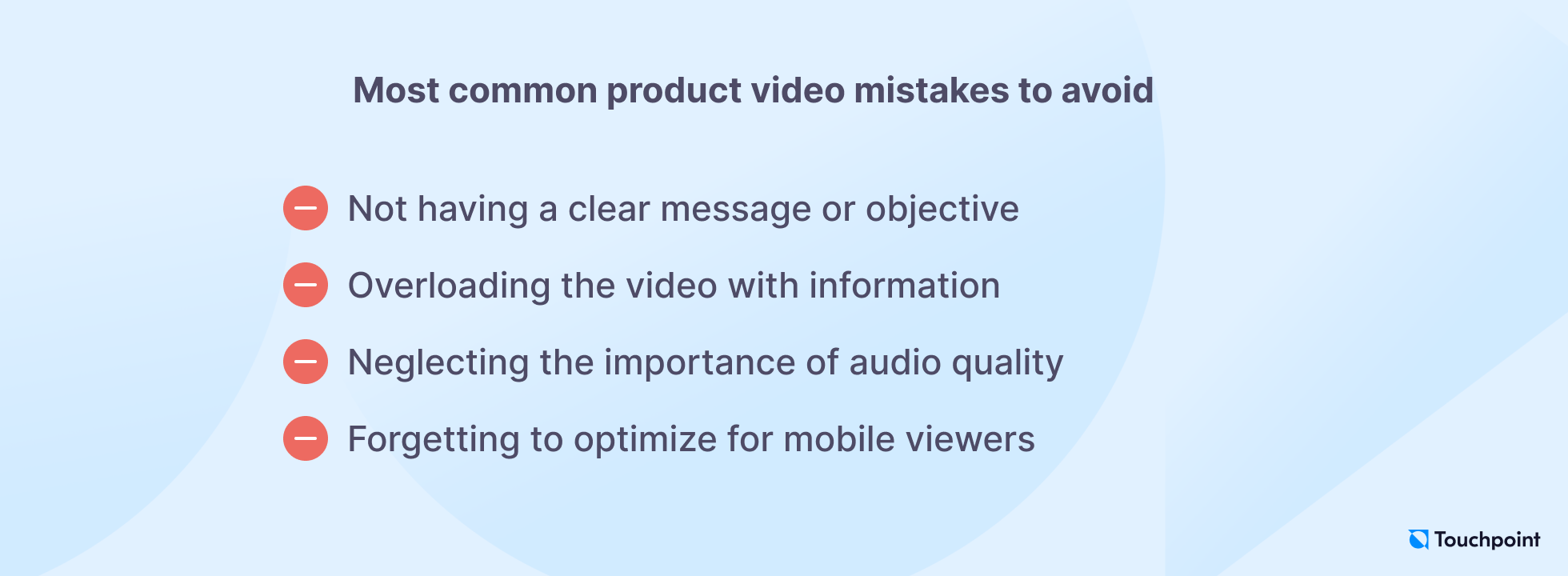
Three brilliant product video examples
Here are some product video examples from the tech industry that outstandingly promote the product showcased.
Amazon Echo: “Alexa Loses Her Voice”
Amazon’s “Alexa Loses Her Voice” commercial is clever and humorous. The video portrays unexpected scenarios where celebrities and personalities substitute for Alexa, adding a playful twist to the product’s demonstration. The humor keeps viewers engaged while effectively showcasing the device’s capabilities and versatility.
The humor and surprise element in this commercial makes it highly shareable and memorable. It creates a positive brand image and effectively highlights the product’s main features, encouraging potential customers to consider Amazon Echo for its entertainment and convenience aspects.
GoPro: “HERO9 Black – More Everything”
GoPro’s video for the HERO9 Black is visually stunning and exhilarating. It showcases the camera’s capabilities through a montage of action-packed scenes, emphasizing its advanced features like 5K video and 20MP photos.
The video effectively communicates how the product can capture incredible moments, sparking excitement in potential customers and tapping into the adventurous spirit of GoPro’s target audience. The fast-paced, dynamic visuals showcase the product’s high-quality performance, compelling adventure enthusiasts to envision using it.
Apple AirPods Pro: “Jump”
Apple’s AirPods Pro commercial titled “Jump” is a masterful blend of aesthetics, music, and storytelling. The video begins with a young dancer navigating the bustling streets of a city. As she listens to music on her AirPods Pro, she is inspired to start dancing.
The choice of music, energetic choreography, and stunning visuals create an emotional connection, showcasing the product’s features in a captivating and memorable manner. It encapsulates Apple’s signature style of combining innovation with a lifestyle, making it appealing to both audiophiles and those seeking a premium audio experience.
Ready to create your own product video?
Crafting our inaugural product video was a journey of creativity and innovation. By sharing our experience with the process, we aim to inspire fellow creators to develop a product video that will astonish their viewers.
As we continue to refine our approach and embark on exciting endeavors, we invite you to stay tuned for more captivating product videos from Touchpoint. Thank you for being a part of our journey, as we look forward to delivering content that surpasses your expectations. Stay connected and stay inspired!
Related articles
What is SMS OTP (One-Time Passcode) verification?
As more and more businesses nowadays increasingly mo...
EZ Texting vs Textmagic: Features, pricing, and use case comparison
Choosing the right business texting solution isn’t j...
Welcome emails done right: 15 Templates for every occasion
In business, much like in personal encounters, the i...
Boost sales with SMS: How texting can help you close more deals
In today’s rapidly evolving business landscape...
Travel marketing for agencies: Latest strategies and SMS solutions
The travel industry has been expanding shoulder to s...




